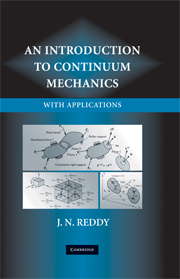Book contents
- Frontmatter
- Contents
- Preface
- 1 Introduction
- 2 Vectors and Tensors
- 3 Kinematics of Continua
- 4 Stress Measures
- 5 Conservation of Mass, Momenta, and Energy
- 6 Constitutive Equations
- 7 Linearized Elasticity Problems
- 8 Fluid Mechanics and Heat Transfer Problems
- 9 Linear Viscoelasticity
- References
- Answers to Selected Problems
- Index
6 - Constitutive Equations
- Frontmatter
- Contents
- Preface
- 1 Introduction
- 2 Vectors and Tensors
- 3 Kinematics of Continua
- 4 Stress Measures
- 5 Conservation of Mass, Momenta, and Energy
- 6 Constitutive Equations
- 7 Linearized Elasticity Problems
- 8 Fluid Mechanics and Heat Transfer Problems
- 9 Linear Viscoelasticity
- References
- Answers to Selected Problems
- Index
Summary
What we need is imagination. We have to find a new view of the world.
Richard FeynmanThe farther the experiment is from theory, the closer it is to the Nobel Prize.
Joliet-CurieIntroduction
The kinematic relations developed in Chapter 3, and the principles of conservation of mass and momenta and thermodynamic principles discussed in Chapter 5, are applicable to any continuum irrespective of its physical constitution. The kinematic variables such as the strains and temperature gradient, and kinetic variables such as the stresses and heat flux were introduced independently of each other. Constitutive equations are those relations that connect the primary field variables (e.g., ρ, T, x, and u or v) to the secondary field variables (e.g., e, q, and σ). Constitutive equations are not derived from any physical principles, although they are subject to obeying certain rules and the entropy inequality. In essence, constitutive equations are mathematical models of the behavior of materials that are validated against experimental results. The differences between theoretical predictions and experimental findings are often attributed to inaccurate representation of the constitutive behavior.
First, we review certain terminologies that were already introduced in beginning courses on mechanics of materials. A material body is said to be homogeneous if the material properties are the same throughout the body (i.e., independent of position). In a heterogeneous body, the material properties are a function of position.
- Type
- Chapter
- Information
- An Introduction to Continuum Mechanics , pp. 178 - 209Publisher: Cambridge University PressPrint publication year: 2007



